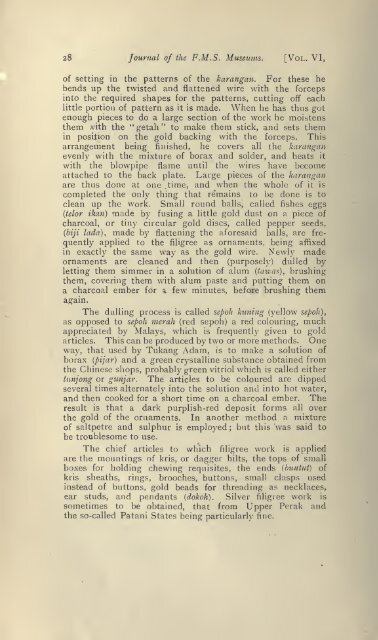Journal of the Federated Malay States museums - Sabrizain.org
Journal of the Federated Malay States museums - Sabrizain.org
Journal of the Federated Malay States museums - Sabrizain.org
Create successful ePaper yourself
Turn your PDF publications into a flip-book with our unique Google optimized e-Paper software.
28 <strong>Journal</strong> <strong>of</strong> <strong>the</strong> F.M.S. Museums. [Vol. VI,<br />
<strong>of</strong> setting in <strong>the</strong> patterns <strong>of</strong> <strong>the</strong> karangan. For <strong>the</strong>se he<br />
bends up <strong>the</strong> twisted and flattened wire with <strong>the</strong> forceps<br />
into <strong>the</strong> required shapes for <strong>the</strong> patterns, cutting <strong>of</strong>f each<br />
little portion <strong>of</strong> pattern as it is made. When he has thus got<br />
enough pieces to do a large section <strong>of</strong> <strong>the</strong> work he moistens<br />
<strong>the</strong>m with <strong>the</strong> "getah" to make <strong>the</strong>m stick, and sets <strong>the</strong>m<br />
in position on <strong>the</strong> gold backing with <strong>the</strong> forceps. This<br />
arrangement being finished, he covers all <strong>the</strong> karangan<br />
evenly with <strong>the</strong> mixture <strong>of</strong> borax and solder, and heats it<br />
with <strong>the</strong> blowpipe flame until <strong>the</strong> wires have become<br />
attached to <strong>the</strong> back plate. Large pieces <strong>of</strong> <strong>the</strong> karangan<br />
are thus done at one time, and when <strong>the</strong> whole <strong>of</strong> it is<br />
completed <strong>the</strong> only thing that remains to be done is to<br />
clean up <strong>the</strong> work. Small round balls, called fishes eggs<br />
{telor than) made by fusing a little gold dust on a piece <strong>of</strong><br />
charcoal, or tiny circular gold discs, called pepper seeds,<br />
(biji lada), made by flattening <strong>the</strong> aforesaid balls, are frequently<br />
applied to <strong>the</strong> filigree as ornaments, being affixed<br />
in exactly <strong>the</strong> same way as <strong>the</strong> gold wire. Newly made<br />
ornaments are cleaned and <strong>the</strong>n (purposely) dulled by<br />
letting <strong>the</strong>m simmer in a solution <strong>of</strong> alum (tawas), brushing<br />
<strong>the</strong>m, covering <strong>the</strong>m with alum paste and putting <strong>the</strong>m on<br />
a charcoal ember for a few minutes, before brushing <strong>the</strong>m<br />
again.<br />
The dulling process is called sepoh kuning (yellow sepoh),<br />
as opposed to sepoh merah (red sepoh) a red colouring, much<br />
appreciated by <strong>Malay</strong>s, which is frequently given to gold<br />
articles. This can be produced by two or more methods. One<br />
way, that used by Tukang Adam, is to make a solution <strong>of</strong><br />
borax (pijar) and a green crystalline substance obtained from<br />
<strong>the</strong> Chinese shops, probably green vitriol which is called ei<strong>the</strong>r<br />
tnnjong or gunjar. The articles to be coloured are dipped<br />
several times alternately into <strong>the</strong> solution and into hot water,<br />
and <strong>the</strong>n cooked for a short time on a charcoal ember. The<br />
result is that a dark purplish-red deposit forms all over<br />
<strong>the</strong> gold <strong>of</strong> <strong>the</strong> ornaments. In ano<strong>the</strong>r method a mixture<br />
<strong>of</strong> saltpetre and sulphur is employed ; but this was said to<br />
be troublesome to use.<br />
The chief articles to which filigree work is applied<br />
are <strong>the</strong> mountings <strong>of</strong> kris, or dagger hilts, <strong>the</strong> tops <strong>of</strong> small<br />
boxes for holding chewing requisites, <strong>the</strong> ends (himtut) <strong>of</strong><br />
kris sheaths, rings, brooches, buttons, small clasps used<br />
instead <strong>of</strong> buttons, gold beads for threading as necklaces,<br />
ear studs, and pendants (dokoh). vSilver filigree work is<br />
sometimes to be obtained, that from Upper Perak and<br />
<strong>the</strong> so-called Patani <strong>States</strong> being particularly fine.

















